SmartSat is proud to be a driving force for developing Australia’s space sector by delivering tangible outcomes to our partners and delivering real-world impact to all Australians through our world-class research. This was the overarching theme of the recent SmartSat CRC Conference 2023, which brought together SmartSat’s valued government, industry and academic partners, researchers, PhD students, staff and colleagues from around the country to reflect on and celebrate the word of the CRC as it enters the second half of its life.
Professor Andy Koronios kicked off the proceedings by welcoming industry, academic and government partners, PhD students, staff, researchers and esteemed guests to the SmartSat CRC Conference 2023. Setting the tone for the remainder of the program, Professor Koronios outlined the theme of the conference was to highlight the real-world impact of SmartSat’s research portfolio, and the positive outcomes satellite research is having for industry, governments, and society more broadly as a result.
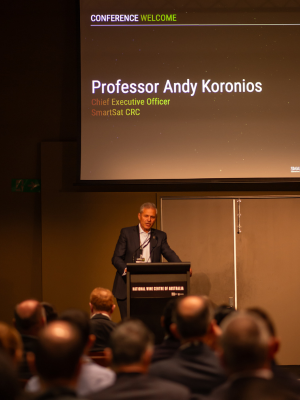 Professor Andy Koronios opens the SmartSat CRC Conference 2023
Professor Andy Koronios opens the SmartSat CRC Conference 2023
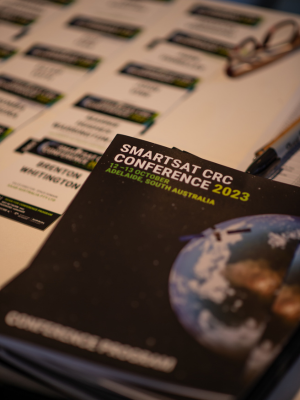 SmartSat CRC Conference 2023 program at the registration desk
SmartSat CRC Conference 2023 program at the registration desk
Professor Koronios then warmly invited Aude Vignelles, General Manager of National Space Capability, Technology & Programs for the Australian Space Agency to present the Keynote Presentation for Day One. Vignelles discussed the role of the Agency in the space sector, in particular through its investment in SmartSat projects such as AquaWatch Australia and Resilient Emergency and Search and Rescue Communications. Overall, the message was overwhelmingly that by continuing to work together, the Australian Space Agency and SmartSat can continue to the strengthen the Australian space sector and improve outcomes for industry.
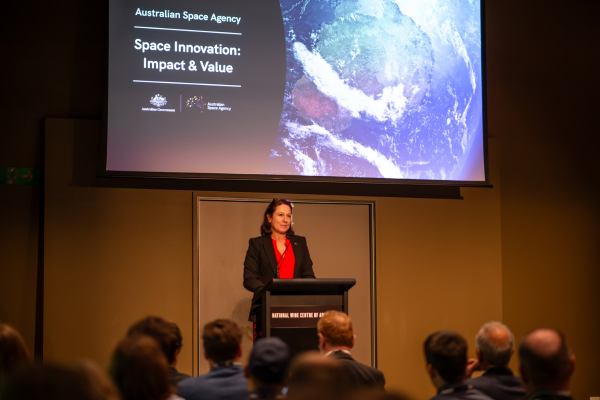 Aude Vignelles, General Manager of National Space Capability, Technology & Programs for the Australian Space Agency presents the Day One Keynote Presentation
Aude Vignelles, General Manager of National Space Capability, Technology & Programs for the Australian Space Agency presents the Day One Keynote Presentation
The first project session for the Conference was chaired by Dr Sarah Cannard and looked at emerging and early-stage projects. This session highlighted three relatively new projects with big growth potential. The first was SCARLET-α, presented by SmartSat Professorial Chair of Artificial Intelligence, Professor Ryszard Kowalczyk. This project, running primarily out of SmartSat’s SCARLET Lab at lot Fourteen, seeks to develop onboard autonomy capability through artificial intelligence in order to enable next-generation space systems able to operate independent of ground control intervention. This project will result in Australian sovereign capability in advanced spacecraft autonomy which can be applied internationally and commercialised by industry, governments and Defence. The next project presented, P1.30 Integrated Tactical Communications, also has defence capability potential. Presented by SmartSat Defence & National Security Coordinator Peter Kerr on behalf of Professor Stephen Hanly from Macquarie University, this research is developing resilient, persistent access layers to space services for a range of disadvantaged user terminals, with a particular focus on Low Earth Orbit satellite networks. Even in the early stages, this project is working closely with Defence to better understand the needs of military tactical communications and to develop mobile SATCOM terminals. Sholto Forbes-Spyratos from CGI Space Defence and Intelligence Australia wrapped up the session, presenting on Project P5.01 Advanced Cooperative Tasking and Intelligent Visualisation Environment for Space Domain Awareness. With space becoming increasingly congested and contested, this research focuses on improving the responsiveness of space domain awareness (SDA) detection and decision cycles. Early-stage demonstrations and simulations have been promising, allowing operators to identify events and action decisions in near real-time.
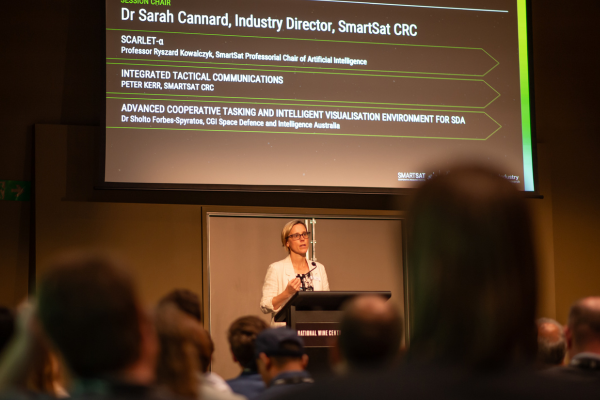 Industry Director Dr Sarah Cannard chairs Project Session 1 ‘Launch Pad: Industry & Project Development (early stage)’
Industry Director Dr Sarah Cannard chairs Project Session 1 ‘Launch Pad: Industry & Project Development (early stage)’
Following a short break for afternoon tea, recently appointed SmartSat Mike Miller Chair in Telecommunications, Professor Craig Smith, provided a brief overview of his research portfolio in optical and hybrid RF communications and how this work is supporting the broader SmartSat mission. Lending from his over 30 years working in the space sector, the overarching lesson Professor Smith shared was that while space is hard, it is in no way an impenetrable market for the Australian economy to support, in large part due to the significant investments being made in the sector and the vibrancy of our start-up community. Supporting this sentiment, the PhD Presentations provided some of SmartSat’s brightest students and Australia’s future space leaders the opportunity to present a five-minute thesis on their research. A selection of students were chosen based on a submitted three-minute thesis to present at the conference in the hopes of being awarded Best PhD Presentation for 2023. These can be viewed on the Conference webpage, alongside all the Technical Posters submitted, here.
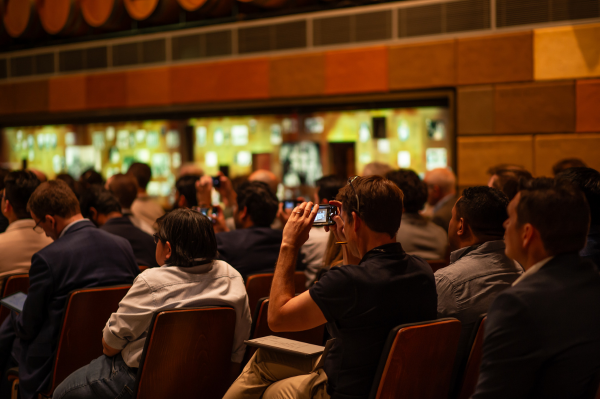 Attendees at the SmartSat CRC Conference 2023
Attendees at the SmartSat CRC Conference 2023
The final session of the day focused on the projects and initiatives underway through SmartSat’s Nodes, chaired by SmartSat Chief Operating Officer Andrew Beveridge. First was a video from Matt Ryall, CEO and Founder of Mawson Rovers on their NSW Node Demonstrator Project P7.12 Enabling Resilient Space Computing with Advanced Thermal Management. Their research into managing heat in satellite chips and other payloads is essential to developing technology that can survive the extreme environment of space. Next up was Peter Toth from Extraterrestrial Power on Project P7.01 & P7.08 Extraterrestrial Radiation Tolerant Silicon Solar Cells, which seeks to produce solar cells that are increasingly resistant to the harsh conditions of space or have the ability to self-heal. Simulations have been conducted on a range of solar cells to assess the influence of various factors on their lifespan and useability, with the outcome bringing us closer to commercially available, sustainable, self-healing solar cells. Moving up the coast, Dr Javier Leon presented his Project out of the Queensland Earth Observation Hub, P6.02 COASTS: Coastal Change Observation and Analytics (multi-) Scale (multi-) Technology System. The research looks at monitoring complex coastal processes through spatial and satellite imagery, numerical modelling, artificial intelligence and related technologies. Finally, the session was rounded out with a presentation from Dr Aiden Price from the Queensland University of Technology on the Living and Playing Together project out of Moreton Bay. This project is an excellent example of how satellite imagery has the capacity to improve so many diverse aspects of our lives, using the example of zoning plans and risk assessments for boating within the Moreton Bay Marine Park.
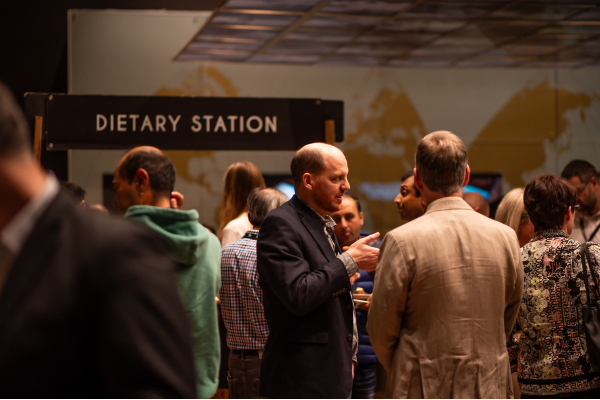 SmartSat Research Program Manager, Dr Andrew Barton, in conversation during the SmartSat CRC Conference 2023
SmartSat Research Program Manager, Dr Andrew Barton, in conversation during the SmartSat CRC Conference 2023
Day Two of the conference saw Professor Andy Koronios invite Chief Defence Scientist and one of the key players in SmartSat’s inception, Professor Tanya Monro AO, to provide a rousing keynote on the importance of collaborative space research to Australia’s Defence forces. The strong relationship between SmartSat and Defence Science & Technology Group (DSTG) is built on a commitment to develop high risk, high pay-off space technologies in partnership with industry that contribute to the Defence Space Innovation, Science & Technology Program. This has resulted in increased capability for the country in what is, according to Professor Monro’s presentation, the most difficult strategic circumstances for our country since WWII.
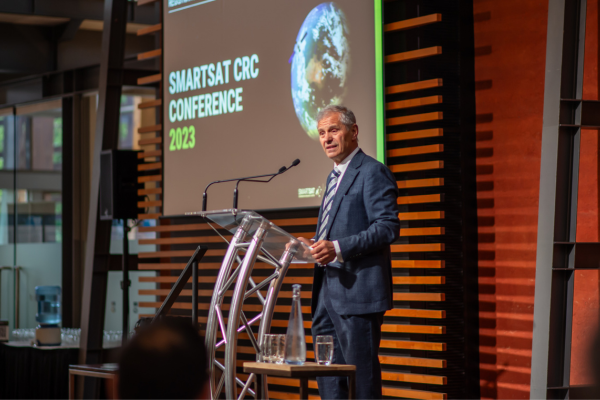 Professor Andy Koronios welcomes attendees to the second day of the conference
Professor Andy Koronios welcomes attendees to the second day of the conference
Following on the theme of innovation of technology was the first project session of the day, chaired by SmartSat Chief Research Officer, Dr Carl Seubert. The session looked at projects that are advancing autonomous systems and artificial intelligence, starting with Project P2.54 SCARLET-β. The project is aimed at developing supporting capability for DSTG’s Buccaneer Main Mission through increased autonomy in self-inspection and Earth Observation (EO) operations. Next was a summary of Project P1.27 Cognitive Satellite Radios to find an autonomous and effective solution for accessing the increasingly radio spectrum for secure satellite communications. As one of SmartSat’s more mature projects, it is currently in a demonstration phase to test interconnectivity using the developed control plane, as well as the synchronized radio resources access, spectrum sensing and initial jamming avoidance algorithms. All these autonomous systems are reliant on precise timing technologies, displayed in Project P2.31 Compact Clock for Small Satellite Applications’ engineering model. This second phase culminates in the testing of a TRL5 proof-of-concept, Engineering Model of a precision space-based clock, which is essential for the development of sovereign timing capability in Australia.
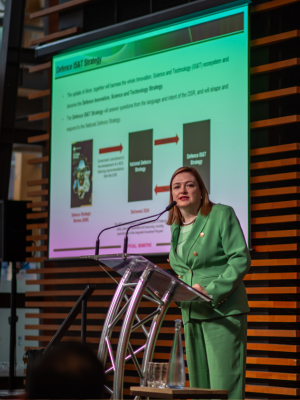 Professor Tanya Monro AC, Chief Defence Scientist, Defence Science and Technology Group gives the Day Two Keynote
Professor Tanya Monro AC, Chief Defence Scientist, Defence Science and Technology Group gives the Day Two Keynote
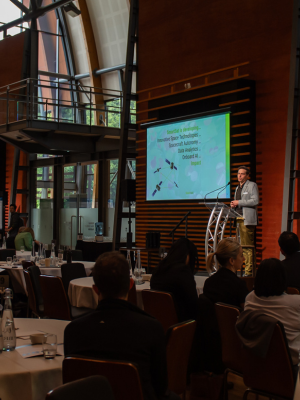 SmartSat CRC Chief Research Officer, Dr Carl Seubert opens the session on advancing autonomy
SmartSat CRC Chief Research Officer, Dr Carl Seubert opens the session on advancing autonomy
Professor Hanna Kurniawati, SmartSat CRC Professorial Chair for System Autonomy, Intelligence and Decision Making provided a brief update into her research portfolio focused on robotics, robot motion planning, integrated planning and learning, and computational geometry applications, and how she is supporting SmartSat’s work in these fields.
After morning tea, SmartSat Research Program Manager, Dr Andrew Barton, chaired a session on SmartSat’s emerging research in EO for the Environment and the benefit of everyday Australians. Most relevant as we head into summer, the session opened with Professor Simon Jones presenting an update on Project P3.04 Real Time Fire Analytics. The team has been working on creating a constellation of satellite observations able to produce next generation fire information for end users. One of those potential end users is the South Australian Government, as represented by South Australian Space Industry Center Director, Dr Catherine Grace, presenting an update on the SA Space Services Mission satellite Kanyini and its potential to test and deliver these emerging technologies through its payloads. Finally, John LeMarshall from ESS Earth Sciences took attendees through his team’s work to design and construct a hyperspectral microwave sounder capable of sounding temperature and moisture and providing hydrometeor information. LeMarshall’s presentation was supported by Fiona Smith from the Bureau of Meteorology on the value such satellite data adds to the agency’s suite of monitoring and predictive technologies. This new generation software defined microwave radiometer demonstrator will additionally allow for development of a market-ready ground-based instrument for improved temperature and hydrometer information for end-users.
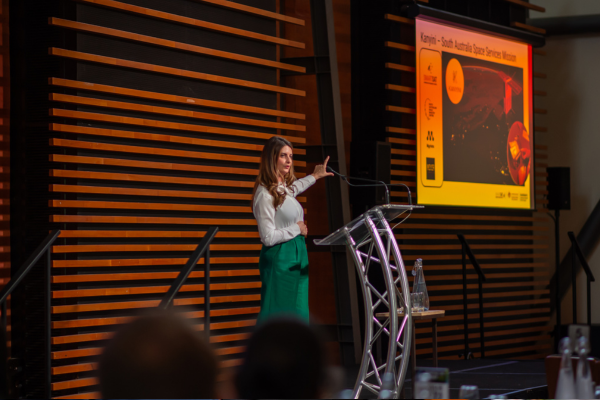 South Australian Space Industry Center Director, Dr Catherine Grace, presenting an update on the SA Space Services Mission satellite Kanyini
South Australian Space Industry Center Director, Dr Catherine Grace, presenting an update on the SA Space Services Mission satellite Kanyini
Before breaking for lunch, the final round of PhD students competing for the best presentation, presenting on projects ranging from satellite autonomy and EO to space law and cyber security policy. All PhD students were encouraged to provide a Technical Poster outlining their research for display at the conference, which attendees were invited to view throughout the day. Project Teams were also invited to present via a technical poster, with all posters eligible to be awarded either Best PhD Poster or Best Project Team Poster for 2023.
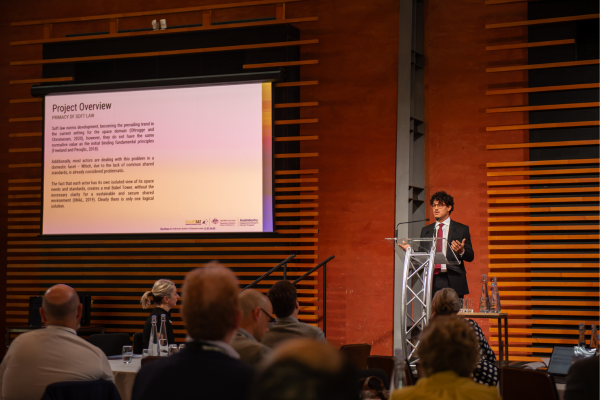 Vinicius Guedes Goncalves de Oliveira presents his five-minute thesis on space infrastructure policy
Vinicius Guedes Goncalves de Oliveira presents his five-minute thesis on space infrastructure policy
The final project session of the conference was led by SmartSat Defence and National Security Coordinator, Peter Kerr, exploring those projects that are now out in the world creating real impact and achieving impact for Australia. Dr Sascha Schediwy was first to share the achievements of Project P1.18 Coherent Free Space Optical, the second phase of which recently demonstrated the optical fiber-like data transfer rates it has made possible through atmospheric free-space communication links at Defence exercise Talisman Sabre. Dr Mark Rice from Safety in Space provided an update on the P1.26 Emergency Communications for LunaSAR project, the second phase of the RESARC project, which is already demonstrating a simple mobile networking infrastructure able to protect astronauts in exposed, high risk locations, as translated from similar real-world application on Earth in natural disaster situations. Professor Jody McKerral provided a brief update on Project P1.24 Spectrum Sensing from Space, which making tangible in-roads into Australian developing a sovereign space-based spectrum monitoring system built on consultation with potential end-users and evaluation of existing technologies. The final presentation from Dr Gerald Bolding covered the progress of the Compact Hybrid Optical-RF User Segment (CHORUS) since it’s unveiling at the 15th Australian Space Forum in May 2023. Testing remains positive at increasing range and elevation, a perfect example of a first-of-its-kind technology that is on the cusp of a new class of satellite communication technology.
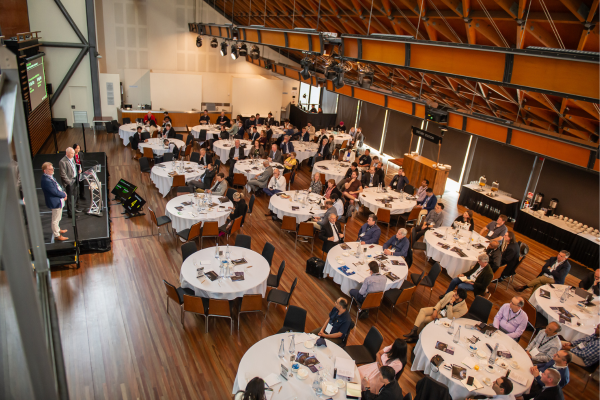 Attendees engaged in Q&A following a presentation from Dr Mark Rice and Dr Feng Rice
Attendees engaged in Q&A following a presentation from Dr Mark Rice and Dr Feng Rice
The CHORUS project is an excellent example of how SmartSat is supporting collaborative space research and delivering real impact to industry. Shena Howell from SHOAL Group Pty Ltd, one of the key project partners, hosted an open discussion on the value SmartSat is delivering to industry by promoting collaboration, stimulating conversation on how to build on this for s stronger sector and better outcomes into the future.
After afternoon tea, the spotlight was on the most recent SmartSat initiative Maya Nula and the real-world applications for space technology in the agricultural sector. Dr Jasmine Muir, Principal Scientist in Earth Observation, opened the session by highlighting the value of the program, before handing over to a panel with representatives from end-user companies DataFarming, Grains Research & Development Corporation and the Department of Primary Industries and Regions’ South Australian Research and Development Institute.
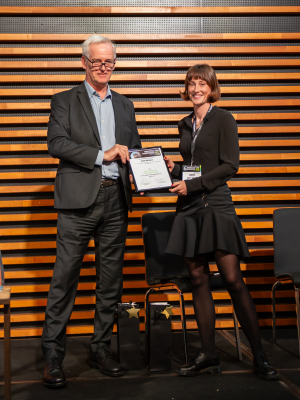 Andrew Seedhouse presents Anne Bettens with the award for Best PhD Presentation
Andrew Seedhouse presents Anne Bettens with the award for Best PhD Presentation
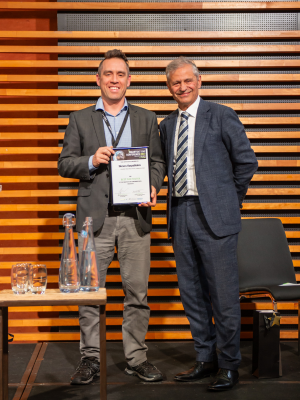 Dr Sascha Schediwy accepts the award for Best PhD Technical Poster on behalf of his PhD student, Skevos Karpathakis, from Professor Andy Koronios
Dr Sascha Schediwy accepts the award for Best PhD Technical Poster on behalf of his PhD student, Skevos Karpathakis, from Professor Andy Koronios
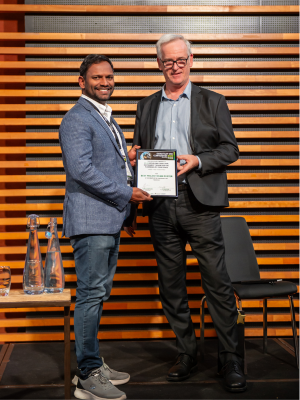 Andrew Seedhouse presents Joice Mathew with the award for Best Project Team Technical Poster
Andrew Seedhouse presents Joice Mathew with the award for Best Project Team Technical Poster
DSTG’s Chief of Cyber, Intelligence and National Security Division, Andrew Seedhouse, generously provided the closing remarks and reflections at the close of the conference. He made particular mention of how great it was to see active collaboration between academia, government and industry all working towards a greater Australian space sector that can protect our sovereign interests and be a major player on the world stage. He also presented the awards for the best PhD Presentation, as well as for best technical poster. Anne Bettens from the University of Sydney won the award for Best PhD Presentation for her work on autonomous navigation of satellites for space exploration, with a special commendation going to Vinicius Guedes Goncalves de Oliveira from Flinders University for his highly engaging analysis of the legal framework around Australia’s space infrastructure. Skevos Karpathakis from the University of Western Australia took out the prize for Best PhD Technical Poster for his project on communications engineering, phase- and spatial-stabilisation system development, while the award for Best Project Team Technical Poster went to Joice Mathew from the Australian National University’s poster on the OzFuel Multispectral Instrument to monitor flammability from space.
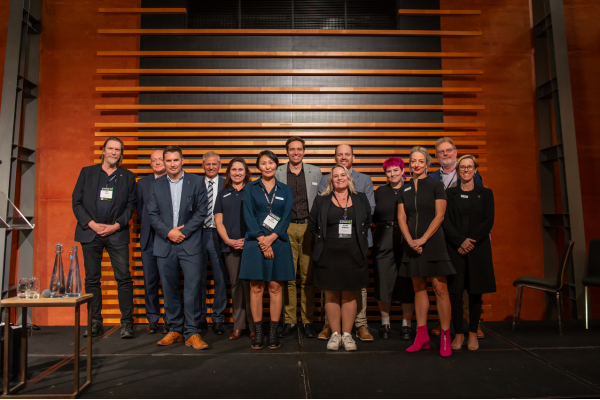 The SmartSat CRC team
The SmartSat CRC team
The overwhelming sentiment from this year’s event was that there is much to do when it comes to developing our local space capability, but by working together and maintaining the current enthusiasm, energy and expertise that has been cultivated through the work of the CRC, Australia has a bright future not only in space, but in harnessing space technologies for the betterment of the economy, the environment and the lives of all Australians.
Click here to see the full Conference photo gallery, technical posters, PhD three-minute thesis videos and more.